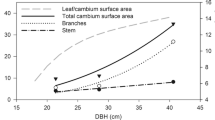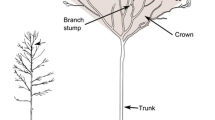Abstract
Architecture of evergreen broadleaf trees in evergreen warm-temperate and tropical forests was analyzed with a ratio (U/Ac) of total surface area of aboveground woody organs to leaf area (one-sided surface area) of each felled tree. The ratio,U/Ac, tended to decrease with the increasing ofdbh. There was little difference in a range of the ratio at eachdbh class between a warmtemperate forest and a tropical rainforest. The ratios of larger trees correlated with their relative growth rates ofdbh among similar sized trees. Canopy trees tended to stop their growth at some value of a ratio, a threshold value being about 1.5, irrespective of forest types. The threshold value showed the critical condition that annual respiration of woody organs of a tree consumed nearly all surplus production. On the basis of the pipe model, an ideal maximum tree height was considered with the ratio, and was estimated at 110 m and 70 m in a tropical rainforest and a warm-temperate forest, respectively.
Similar content being viewed by others
Abbreviations
- dbh :
-
diameter at breast height of a tree
References
Ashton, P.S. 1971. IBP Malayan Project. Pasoh forest reserve vegetation survey, Second Report.
Halle, F., Oldeman, R.A.A. andTomlinson, P.B. 1978. Tropical trees and forests-An architectural analysis. Springer-Verlag, Berlin Heidelberg New York.
Karizumi, N. 1978. Underground biomass.In T. Kira, Y. Ono and T. Hosokawa ed., Biological production in a warm-temperate evergreen oak forest of Japan, JIBP Synthesis18: pp. 82–88. Univ. of Tokyo Press, Tokyo.
Kato, R., Tadaki, Y. andOgawa, H. 1978. Plant biomass and growth increment studies in Pasoh Forest. Malay. Nat. J.,30: 211–224.
Kira, T. 1978. Introduction (Chap. 1 Vegetation and physical environment).In T. Kira, Y. Ono and T. Hosokawa ed., Biological production in a warm-temperate evergreen oak forest of Japan, JIBP Synthesis18: pp. 1–7. Univ. of Tokyo Press, Tokyo.
Kira, T. 1987. Primary production and carbon cycling in a primeval lowland rainforest of peninsular Malaysia.In M.R. Sethuraj and A.S. Raghavendra ed., Tree crop physiology, pp. 99–119. Elsevier Science Publishers, Amsterdam.
Kira, T. andYabuki, K. 1978. Primary production rates in the Minamata forest.In T. Kira, Y. Ono and T. Hosokawa ed., Biological production in a warm-temperate evergreen oak forest of Japan, JIBP Synthesis18: pp. 131–138. Univ. of Tokyo Press, Tokyo.
Kurachi, N., Hagihara, A. andHozumi, K. 1986. Evaluation of the light interception by nonphotosynthetic organs in aLarix leptolepis plantation. Ecol. Res.1: 173–183.
Monsi, M. andSaeki, T. 1953. Uber den Lichtfaktor in den Plan zengesellshaften und seine Bedeutung fur die Stoffproduktion. Jap. J. Bot.14: 22–52.
Nagano, M. andKira, T. 1978. Aboveground biomass.In T. Kira, Y. Ono and T. Hosokawa ed., Biological production in a warm-temperate evergreen oak forest of Japan, JIBP Synthesis18: pp. 69–82. Univ. of Tokyo Press, Tokyo.
Nishioka, M., Hozumi, K., Kirita, H. andNagano, M. 1978. Estimation of canopy photosysthesis and respiration. Ibid.In. pp. 99–111.
Ogawa, H. 1977. Principles and methods of estimating primary production in forests.In T. Shidei and T. Kira ed., Primary productivity of Japanese forests, JIBP Synthesis16: pp. 29–35. Univ. of Tokyo Press, Tokyo.
Ogawa, H., Yoda, K., Ogino, K., andKira, T. 1965. Comparative ecological studies on three main types of forest vegetation in Thailand. II. Plant biomass. Nature and Life in SE Asia4: 49–80.
Ogino, K. 1977. A beech forest at Ashiu: biomass, its increment and net production.In T. Shidei and T. Kira ed., Primary productivity of Japanese forests, JIBP Synthesis16: pp. 172–186. Univ. of Tokyo Press, Tokyo.
Omura, M., Miyata, I. andHosokawa, T. 1978. Vegetation types and association analysis.In T. Kira, Y. Ono and T. Hosokawa ed., Biological production in a warm-temperate evergreen oak forest of Japan, JIBP Synthesis,18: pp. 8–21. Univ. of Tokyo Press, Tokyo.
Oohata, S. andShidei, T. 1974. A study on the annual change of net productivity in the forest communities. Bull. Kyoto Univ. For.46: 40–50 (in Japanese)
Oohata, S. andShinozaki, K. 1979. A statical model of plant form further analysis of the pipe model theory. Jpn. J. Ecol.29: 323–335.
Research Group on Forest Productivity of the Four Universities. 1960. Studies on the productivity of the forest. I. Essential needle-leaved forests of Hokkaido. Kokusaku Pulp Ind. Co., Tokyo, (in Japanese)
Shinozaki, K., Yoda, K., Hozumi, K. andKira, T. 1964. A quantitative analysis of plant form-the pipe model theory. I & II. Jpn. J. Ecol.14: 97–105, 133–139.
Tadaki, Y. 1977. Gross production.In T. Shidei and T. Kira ed., Primary productivity of Japanese forests, JIBP Synthesis16: pp. 108–112. Univ. of Tokyo Press, Tokyo.
Whittaker, R. H. andWoodwell, G.M. 1967. Surface area relations of woody plants and forest communities. Am. J. Bot.54: 931–939.
Yamakura, T., Hagihara, A., Sukardjo, S. andOgawa, H. 1986. Tree size in a mature dipterocarp forest stand in Sebulu, East Kali mantan, Indonesia. Southeast Asian Studies23: 452–478.
Yamakura, T., Hagihara, A., Sukardjo, S. andOgawa, H. 1987. Tree form in a mixed dipterocarp forest in Indonesian Borneo. Ecol. Res.2: 215–227.
Yim, Y.J., Ogawa, H. andKira, T. 1969. Light interception by stems in plant communities. Jpn. J. Ecol.19: 233–238.
Yoda, K. 1971. Ecology of a forest. Chikujishokan, Tokyo. (in Japanese)
Yoda, K. 1978. Estimation of community respiration.In T. Kira, Y. Ono and T. Hosokawa ed., Biological production in a warm-temperate evergreen oak forest of Japan, JIBP Synthesis18: pp. 112–131. Univ. of Tokyo Press, Tokyo.
Yoda, K. 1983. Community respiration in a lowland rain forest at Pasoh, Peninsular Malaysia. Jpn. J. Ecol.,33: 183–197.
Author information
Authors and Affiliations
Rights and permissions
About this article
Cite this article
Yoneda, T. Surface area of woody organs of an evergreen broadleaf forest tree in Japan and Southeast Asia. J. Plant Res. 106, 229–237 (1993). https://doi.org/10.1007/BF02344590
Received:
Accepted:
Issue Date:
DOI: https://doi.org/10.1007/BF02344590




